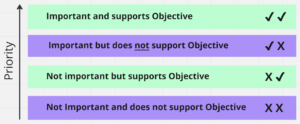
Beginner Read Audience Data Collection and Evaluation
Audience research is the process of gathering information about the people who visit you or see your work, use your services, or engage with your organisation.
In this article

Sticky Situation, Photo by JD
Do you often find yourself juggling 10 different tasks at once? Do you find you are not doing things as well as you know you could? If this sounds familiar, please read on!
This article will help you to streamline your marketing. The aim is to remove the grey areas, the wishy-washy parts of your current plans or routines, and redirect focus towards feasible and sustainable goals, ones that are more certain. After reading this article, if I could hope for any two outcomes, they would be:
Across the creative and cultural sector, it is common for organisations to have extremely ambitious goals, but equally, vastly under resourced teams. When capacity is low and expectations are high, efficiency can decrease significantly if the people, systems, or technologies responsible for managing tasks are overwhelmed or poorly managed. One idea is that saying no to things through strategic prioritisation is a compelling way for organisations and teams to become more efficient. Signs are showing that a 4-day working week does not decrease productivity in the workplace, so why not apply this logic of moderation to our marketing goals and activities?
It is widely considered by strategists that if an organisation has limited resources, the best way to overcome the challenge is through clever design or tighter coordination. Highly regarded strategist, Richard Rumelt, and author of ‘Good Strategy Bad Strategy’ suggests:
“At the core, strategy is about focus, and most organisations don’t focus their resources. Instead, they pursue multiple goals at once, not concentrating enough resources to achieve a breakthrough in any of them.”
With this statement in mind, if tasks were removed from your ‘to-do-list’ it would liberate you to focus on fewer things to make a big leap in key areas. It is this improved focus that will help you to increase your chances of accomplishing your objectives. By effectively doing less, you will be able to amplify the things that matter, while dissolving the things that do not.
The next section looks at 3 steps you can take to streamline your marketing while still hitting important targets: prioritise, review and coordinate.

Before we proceed, here are definitions for terms used throughout the next section:
Completing the exercise below is the first step to streamlining your marketing plan. The aim is to identify the best opportunities you have in front of you and to select a near-term objective to work towards. Choosing a near-term objective is an important part of the process. It must be attainable as it will provide the focal point for your prioritisation. Let us get to it.
PRO TIP: Ranking items using two or more criteria is an excellent way to highlight outlying goals, making filtering, and ordering a lot easier to manage. The diagram below demonstrates combining ‘Important’ goals with goals that ‘Support Objectives’ to reach an outcome.

PRO TIP: Using a matrix is a helpful way to prioritise and rank tasks. Try, ‘most likely to achieve goals’ on one axis, and ‘easiest to execute’ on another, or experiment using other conditions. A Miro Board is a great online tool for this.

Once you have settled on a timeline with a distilled set of goals and an inventory of practical activities, you now have the framework of a marketing plan.

Sharp decisions have been made in Step 1. The crucial next step is to review your new goals and activities to make sure that the plan is underpinned by fundamental principles in strategy theory. Two principles that need special attention are:
Your marketing plan now leverages your or your organisation’s unique opportunity and strengths. At this point, it would be advised to present the plan to the senior team/board for approval. A favorable knock-on effect of having a more focused set of goals and targets is that your board or directors will often respond well to better numbers in fewer areas.
If all parts of your plan are coordinated, you instantly create more power. Imagine a game of tug of war; a weaker team working as one unit can easily overpower a team of stronger individuals who are not pulling together. The last step examines which components of the plan are working in harmony and which are not. Once identified, solutions that will make the plan more coordinated can be fostered or acquired. Areas that typically require close attention when plans or systems change are:
At this point, your marketing plan will be in great shape. It will be aligned towards an important near-term objective – one in which goals have been chosen to act like stepping stones for success, and crucially have been agreed upon by all stakeholders. How everything fits together has been considered so that if gaps need filling, essential resources, skills, or people needed to execute the plan can be put in place. Not only that, but by coordinating actions between its various moving parts, the plan will be more powerful and more resilient.
Improved alignment, focus, and coordination free up time and wasted energy over the length of any project – therefore marketing plans become more efficient and effective, even after parts have been taken away. To end in the words of the great American artist, Sol Lewitt “It is difficult to bungle a good idea.”

Does this sound like something that would work for you or your organisation?
The ideas presented in this article are rooted in strategy theory but have been developing naturally throughout my time as a digital marketing and strategy consultant for Arts Council England. If you have feedback or wish to share your ideas for ways to improve this exercise, please email me at [email protected]. I would love to hear from you!
The Digital Culture Network is here to support you or your organisation. Our Tech Champions can provide free 1-2-1 support to all creative and cultural individuals and organisations who are in receipt of, or eligible for, Arts Council England funding. If you need help or would like to chat with us about any of the advice we have covered above, please get in touch. Sign up for our newsletter below and follow us on Twitter @ace_dcn and LinkedIn for the latest updates.
Beginner Read Audience Data Collection and Evaluation
Audience research is the process of gathering information about the people who visit you or see your work, use your services, or engage with your organisation.
Beginner Read Digital Accessibility
The goal of digital accessibility is to create digital products and services that are inclusive and provide equal access to information and functionality to all users, regardless of their abilities. This article aims to introduce you to the principles of digital accessibility, and shed some light on some of the things you need to know when creating accessible digital content.
Beginner Read Digital Strategy
An effective digital strategy can be vital to your organisation’s success. Read on to understand the key considerations when developing yours.
Beginner Read Data Analytics and Insight Digital Marketing
Excel is arguably the most powerful software at sorting data into meaningful categories and the go-to tool for most marketers and data analysts, particularly when it comes to reporting. This article will introduce you to ten functions, formulas and shortcuts to try next time you are manipulating your metrics.
Beginner Read Digital Marketing Digital Strategy Social Media
Writing a landing page headline in 6 to 12 words is not as simple as it first appears but there is a straightforward process you can follow to move from a poor-performing headline, to one that performs. Read on to learn about the key steps you should consider following to optimise your landing page headlines.
Beginner Read Digital Strategy
This article aims to provide compelling reasons why creative and cultural organisations and individuals should continue to put emphasis on their digital strategy so that they can adapt to change and drive better results.




